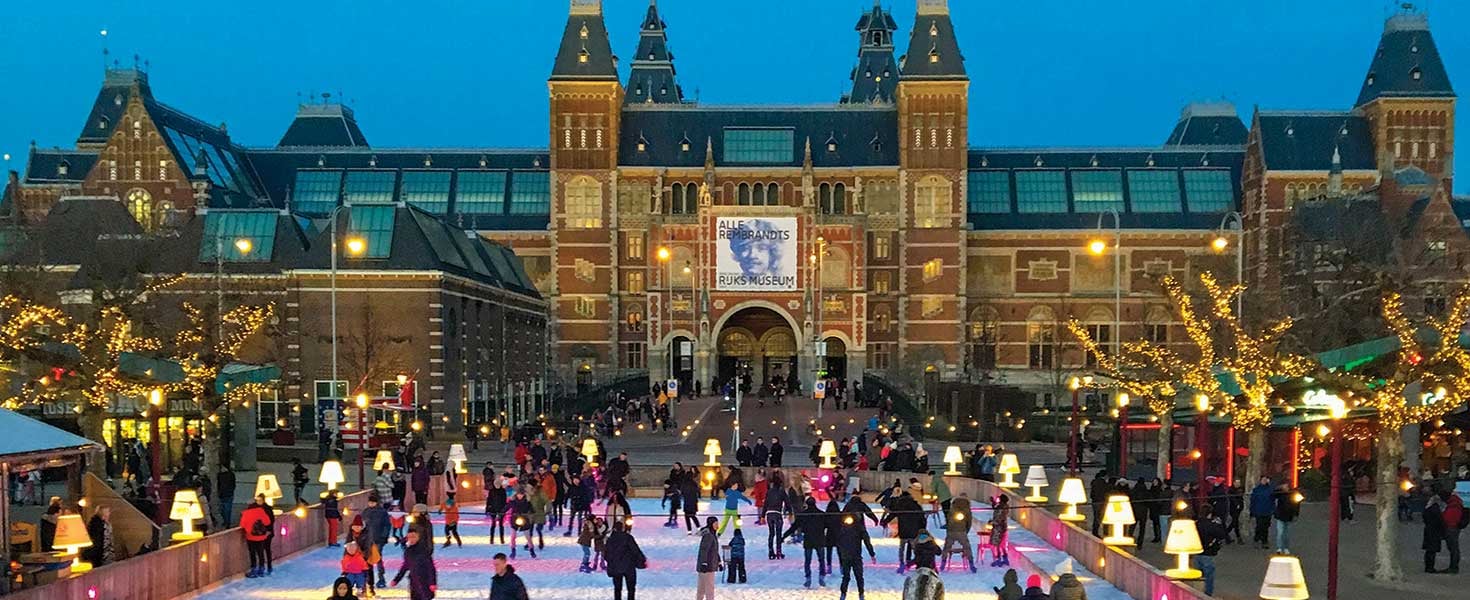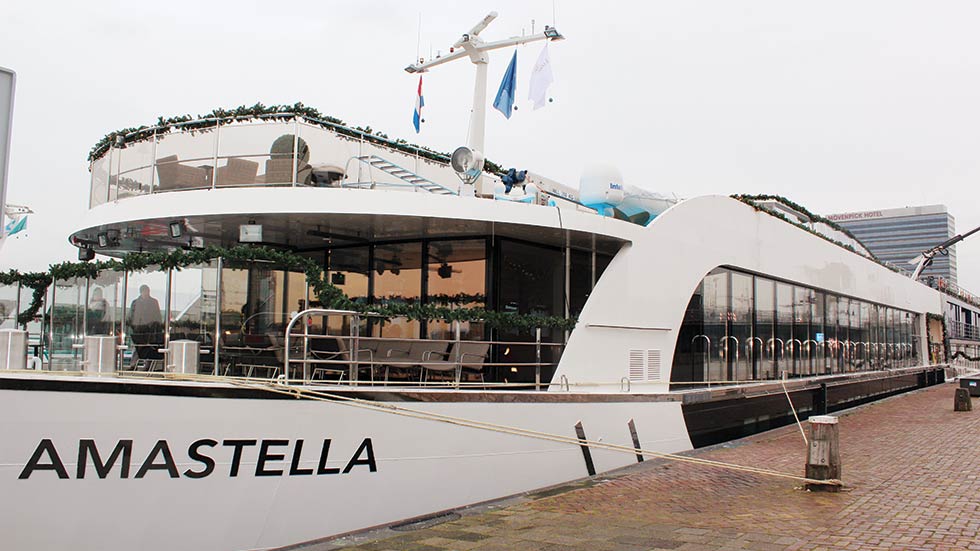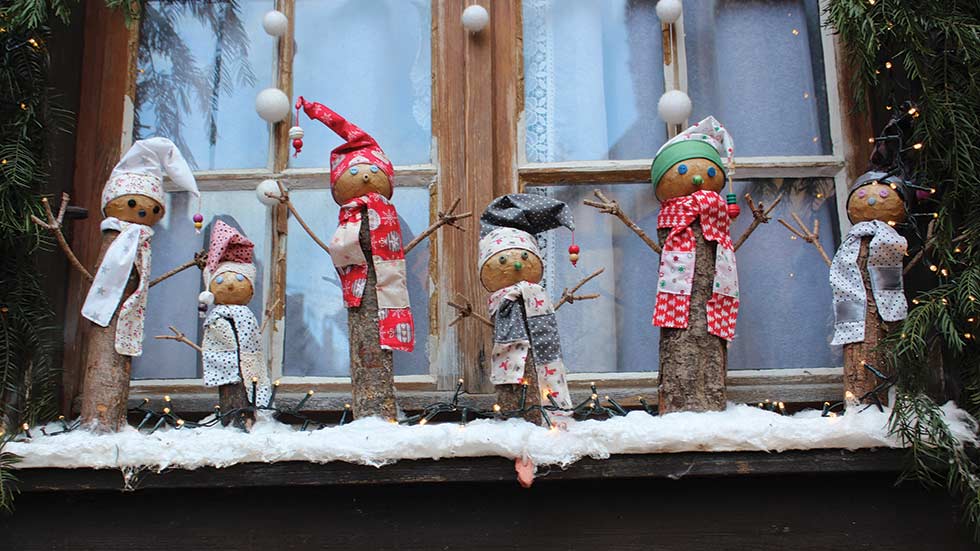The Most Wonderful Rhine Of The Year
Snow or no snow, the holiday spirit was flowing on this Christmas market cruise


The Rijksmuseum provides a dramatic backdrop to the Christmas market in Amsterdam’s Museum Square.
Photo by SJO
I arrived in the Netherlands on a drizzly December day with temperatures in the high 40s. Well, I thought, so much for my fantasy that a Christmas market cruise along the Rhine would be like living inside a snow globe. I had hoped to see modern-day Hans Brinkers skating on the canals of Amsterdam, but it had been years since winters had been cold enough for the water to freeze, my Uber drive told me. With an afternoon to myself before dinner on the AmaStella, I headed to the Rijksmuseum to view paintings by the Old Dutch Masters.
When I emerged into the evening darkness a few hours later and walked to the greenspace that fronts the museum, I saw my hoped-for skaters: dozens of children and adults circling a manmade rink to the accompaniment of lively prerecorded music. Multicolored strobes lit the festive scene, the smell of fried food filled the air, and groups of friends gathered around tables to toast the season with glühwein, the warm mulled wine that is a fixture at European Christmas markets. My cruise had not yet started, and the weather forecast for the coming week had not a hint of snow, but the merriment in Museum Square had awakened my holiday spirit.

As we cruised along the Rhine, we noted that AmaWaterways ships looked more festive than those of other cruise lines.
Photo by Theresa G. Medoff
THE FESTIVE SEASON
Back on the ship an hour later, I joined the 150 or so other passengers who had gathered in the lounge for the captain’s welcome reception. My adult daughter, Katrina, would be traveling with me on the weeklong AmaWaterways Rhine River cruise, but she wasn’t arriving until early the next morning. So, champagne in hand, I set out to make some new friends. The other guests, most of them from the U.S., included a honeymoon couple in their 30s, a handful of couples celebrating milestone anniversaries, mother-and-daughter pairs, groups of friends, and about a half-dozen two- and three-generation family groups. We all shared a single aspiration: to immerse ourselves in the magic of Christmas season along the Rhine.
The modern Christmas tree, as many know, originated in Germany in the 16th century, and we can thank the Germans for glass ornaments and tinsel, too. The Advent calendar and the Advent wreath likewise come to us from German-speaking Europe, as do many beloved Christmas carols. And while Christmas markets are now prevalent in many places around the world, including the U.S., these festive outdoor shopping venues have variously been traced back to a 1384 Christkindlmarkt in the German state of Saxony and an Advent market in Vienna, Austria, a century earlier. Today, residents of Germany, Switzerland, Austria and France’s Alsace region get just as much pleasure as their ancestors from extravagant décor and seasonal celebration, making a December trip to these regions something extra-special.

The Cathedral Christmas market in Cologne features some 150 artisans and food vendors in charming wooden chalets.
Photo by Theresa G. Medoff
Like other river cruise lines, AmaWaterways extends that festive atmosphere to life on board. The AmaStella was festooned with lights and greenery inside and out, and Christmas trees and luminaries adorned the lobby, restaurant and lounge. Meals included local seasonal fare, and snack time brought trays of gingerbread and stollen, a traditional German bread made with nuts, spices and dried fruit.
Evenings on board included holiday entertainment and events. One night brought a Christmas traditions party with music, stories and tree-decorating (a real delight for Lucky and Lindy, a young South African couple who had never before experienced this Western Christmas tradition). On another evening, guests caroled along with the crew, and Santa Claus appeared with his pack full of gifts.
In a nod to German tradition, guests were told one night to leave a slipper outside our cabin doors. We awoke the next morning to find that St. Nicholas had visited, leaving foiled-wrapped molded Christmas chocolates. My daughter and I received a St. Nicholas and a Krampus, the half-goat/half-demon who punishes children who misbehave. Naturally, I decided that the Krampus must have been intended for my daughter!
THE ROMANTIC RHINE
The Rhine flows 820 miles from its origin in the Swiss Alps to the Netherlands, where it merges with the Scheldt and Maas Rivers and empties into the North Sea. Our cruise on the AmaStella would head upstream from Amsterdam to Basel, Switzerland, stopping in Germany and France at ports as varied as Cologne, Germany, a city of one million famous for its 13th-century Gothic cathedral, and Riquewihr, France, a village with just 1,500 inhabitants that retains its medieval heart, having largely escaped damage in World War II.

Hilltop castles are the top attraction in Germany’s Upper Middle Rhine Valley.
Photo by Theresa G. Medoff
Along the way, we would pass mountainsides covered in steeply terraced vineyards that yield grapes for the Rhine Valley’s celebrated wines. Industrial ports punctuate the riverside occasionally, as the Rhine is a major shipping channel, but these commercial scenes are far outnumbered by charming riverside towns, each with a church, an inn, a local park and, in the most famous stretch of the Rhine, castle upon castle perched high above the towns, just like in a fairy tale.
SAILING AWAY
Before departing Amsterdam, AmaStella guests boarded numerous small boats for guided cruises of the legendary canals that have given the city the nickname “Venice of the North.” Afterward, Katrina and I walked from our cruise ship to the city’s Inner Canal Ring and the Red Light District (relatively tame during the day, though eyebrow-raising for some Americans). We meandered along the canals, browsed shops ranging from cheesemongers to cannabis emporiums, and, in search of a hot drink, naively ended up in a “coffee shop”—code in Amsterdam for cafés focused on the weed experience. Coffee shops also sell hot drinks, so we ordered hot chocolates and sipped them in the outdoor café.
The following afternoon, our ship docked near Cologne, Germany’s historic area, and we joined a guided walking tour for an in-depth look at the city’s monumental cathedral, the largest in Northern Europe. Construction on the impressive edifice had begun in 1248, but it was not completed until 660 years later. Katrina and I had visited the cathedral years before on a family trip, but we were awed once more by its flying buttresses, soaring twin spires and marble altar—and by the sheer ingenuity required to build this structure long before modern construction processes existed.
Our local guide introduced us to a half-dozen nearby Christmas markets, and Katrina and I shopped and tasted our way through the city before returning to the ship at 10:30 p.m. We feasted on potato pancakes, wursts, roasted caramelized almonds, gingerbread and Belgian-style waffles topped with powdered sugar, all accompanied by the obligatory glühwein for Katrina and, for me, Kölsch, the clear, straw-colored beer that originated in Cologne. We passed on roasted chestnuts but stopped to snap a photo of a smiling bespectacled vendor with his top hat and jaunty red scarf.

Roasted chestnuts are a holiday treat served at Christmas markets in the Rhine region.
Photo by Theresa G. Medoff
Rhine cruises are noted above all for the journey through the Upper Middle Rhine Valley, a 40-mile stretch of river featuring castle after castle—some 40 hilltop castles and fortresses built over a 1,000-year period. Castle-sightings begin early morning in Koblenz with Ehrenbreitstein, a 19th-century fortress 400 feet above the city that now houses several museums, restaurants and a youth hostel. During the five hours we cruised through this picturesque region, the cruise director provided well-timed commentary for the guests, who watched through picture windows in the toasty lounge or camped out on the sundeck bundled in blankets.
As we passed the 433-foot-high steep slate rock face named Lorelei Rock—where many a river ship had wrecked, giving rise to the legend of the mermaid Lorelei—we toasted with a hot cup of spiked Rüdesheimer coffee and listened to Heinrich Heine’s song “Die Lorelei.”
The castles ended just before Rüdesheim, an attractive German winemaking town of 10,000 that attracts as many as three million visitors a year. There, we capped off a gondola ride over the vineyards with a few hours in the Christmas markets and a stop at a café for more Rüdesheimer coffee. The tableside preparation of the drink is a big production; the restaurant’s lights were dimmed just before the waiter poured local Asbach Uralt brandy in a special cup, added precisely three sugar cubes and then set the mixture aflame for one minute before adding strong hot coffee, thick whipped cream and a garnish of chocolate shavings.
TO MARKET, TO MARKET
The days to come followed a familiar pattern of docking in a new city or town, embarking on a tour with a local guide, and then spending free time browsing Christmas markets, exploring museums or whatever else we found of interest. While the schedule was predictable, the scenery, the attractions and even the Christmas markets differed at every stop.
In Heidelberg, Germany, we toured the ruins of a castle that is among the most important Renaissance structures north of the Alps and then set off on a quest to find me the perfect nutcracker. In Strasbourg, France, a short bus tour of the city that serves as the seat of the European Parliament and the European Court of Human Rights was followed by a guided walking tour of the Grand Île (Grand Isle), the historic city center, which is classified as a UNESCO World Heritage Site. Rivers and canals wend through the oldest part of Strasbourg, and the narrow cobblestone streets lined by slanting, half-timbered buildings all accented by holiday decorations were breathtaking.

Residents and businesses decorate in ways both elegant and whimsical.
Photo by Theresa G. Medoff
Dusting off the French she’d last used in college, my daughter ordered us a sweet treat at a cozy crêperie near Cathedral Notre Dame de Strasbourg. We stopped in stores and strolled through the outdoor markets, and Katrina chatted away, talking with a street artist about her paintings and ordering an assortment of cookies at the market in Petit-France, the city’s picturesque medieval quarter.
We loved the Alsace region so much that on the final full day of the cruise, when guests could visit a small town in either France or Germany, we chose Riquewihr, the frozen-in-time 16th-century French hamlet that inspired the animators of Disney’s Beauty and the Beast movie. By this point, we knew exactly what we wanted to purchase at the Christmas markets: bretzels (baked soft pretzels), cheeses, macarons and other French confections, and Alsatian wines and fruit liqueurs.
Back on the AmaStella that evening, we shared a wheel of creamy, tangy munster cheese with the new friends we’d made on the trip. Our spirits were high as we toasted the season with local wine. Outside, the rain was falling, but in my heart, it was snow.
SEASONS ON THE RHINE
River cruisers love the Rhine. And why not? The scenery is enchanting, and ports provide easy access to historical, cultural, artistic and culinary highlights. Most cruise lines ply the river from mid-March to late December, and every season offers its own appeal.
SPRING
Spring is an ideal time to add a pre- or post-cruise extension in Amsterdam. Bicycle with the locals, take a canal boat tour, and visit the Anne Frank House and the Van Gogh Museum. Between late March and early June, the 80-acre Keukenhof flower show in Lisse, Netherlands, is a must-do.
The season bring the return of white storks from their winter grounds in Africa to France’s Alsace region. Long a symbol of the area, this impressive bird stands nearly four feet tall and has a wingspan of up to seven feet. Everywhere along the Rhine, foliage is greening up, and warming temperatures make outdoor exploration a delight.
SUMMER
Summer brings sunshine and longer days. Guests socialize on deck, read (or nap) on the lounge chairs or take a dip in the pool. As the ship plies the river, open stateroom windows bring birdsong and the whoosh of water.
Pleasant weather inspires many guests to opt for hiking or biking tours in port. Europe is renowned for its outdoor cafes, and dining leisurely in a centuries-old city square is the stuff that fuels dreams of travel.

FALL
Scenery along the river includes mile after mile of golden-hued vineyards terraced into steep hills. The region is best known for its reislings, produced in both dry and sweet varieties, but wineries also make gewurztraminers, pinot gris, pinot blancs and even an Alsatian rosé. Sparkling white Crémant d’Alsace is another specialty.
Wine festivals are held in vineyards and towns throughout the Rhine Valley, and cruise lines offer themed journeys with wine-related excursions and, often, wine experts and wine tastings on board.
WINTER
From late November through Christmas, cities and towns go over the top in decorating with holiday flair. Christmas markets pop up in public squares and along pedestrian streets, with many featuring a carnival ride or two and perhaps an ice-skating rink in addition to artisans in wooden chalets selling handcrafted items.
Those traveling over Thanksgiving enjoy a traditional turkey dinner. Likewise, Christmas Eve and Christmas Day are celebrated in home-away-from-home style. New Year’s Eve calls for a party on board, and with any luck, midnight fireworks will set off the city skyline and reflect colorfully in the river.
